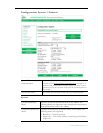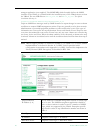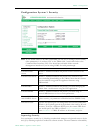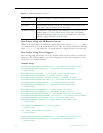
MPEG-2 Configuration
VBrick MPEG-2 Appliance Admin Guide 49
Configuration: System > Security
Improving Security
You can improve security by (1) blocking unauthorized attempts to login and access a device
and (2) by reducing exposure to malicious software attacks. The most common vulnerability
Note If you disable Telnet, FTP, IWS, and SNMP, the only way to manage (and re-enable)
these parameters is to connect a PC to the VBrick with a serial cable and use the
Command Line Interface (CLI). You should never disable all the network
management interfaces if you are using COM2 for serial passthrough.
External Telnet
Server
Default = Enabled. Disabled will prevent Telnet sessions to the
server.
External FTP Server Default = Enabled. Disabled will prevent FTP sessions to the
server including downloading to the VBrick. Note that this feature
must be enabled to upgrade the appliance firmware using
VBDownload.
External IWS Default = Enabled. Disabled will prevent you from managing the
VBrick from a web browser using the IWS application.
External SNMP Default = Enabled. Disabled will prevent you from using an
external MIB browser to view or write parameters.
External SNMPv1
and SNMPv2 Access
Default = Enabled. You can use both SNMP v1/v2, and v3. For
tightest security, set parameter to Disabled and use SNMPv3 only.
IWS Server Port Specifies the listener port for management and HTTP connections.
Default = 80. Typically port 80 is the default value used by PC web
browsers. To access a different HTTP port, the remote IWS client
user would specify the URL as follows:
http://IPaddress:port
where IPaddress = VBrick IP address or hostname, and port.


















